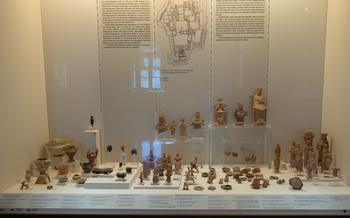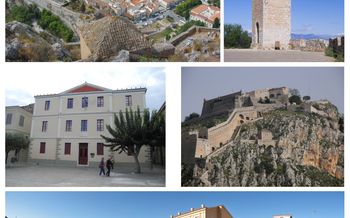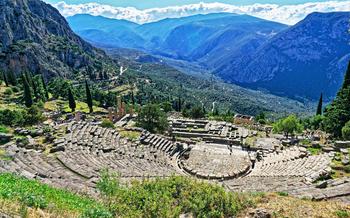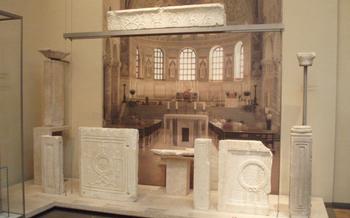
Agios Dimitrios
- Historical Background
- The Agios Dimitrios Church
- The Interior of the Church
- Religious Significance
- Cultural Importance
- The Church Square
- Exploring Hermoupolis
- The Nautical Museum of Syros
- The Industrial Museum of Ermoupolis
- The Archaeological Museum of Syros
- The Apollo Theater
- The Town Hall of Hermoupolis
- The Miaoulis Square
- Insider Tip:
Historical Background
Syros has a rich and diverse history dating back to the ancient times. During the Byzantine Empire, the island was a strategic naval base. In the 13th century, it was captured by the Venetians, who ruled it for over 400 years. During the Greek Revolution (1821-1829), Syros remained neutral, which allowed it to become a safe haven for refugees from other parts of Greece. This led to the rapid growth of Hermoupolis, which quickly became one of the most important ports in Greece. The city's development was further boosted by the establishment of the first Greek shipyard in 183Hermoupolis soon became a major center of shipbuilding and maritime trade, earning the title of "the City of Sailors".
The church of Agios Dimitrios played a significant role in the development of Hermoupolis. It was built in 1824, shortly after the start of the Greek Revolution, and quickly became a symbol of the city's growing prosperity. The church was dedicated to Saint Demetrios, the patron saint of sailors, which reflects the importance of the maritime industry to Hermoupolis.
The Agios Dimitrios Church
The church of Agios Dimitrios, a majestic example of neoclassical architecture, stands as a testament to the city's rich past. Its construction, commissioned by the wealthy merchant Georgios Sisinis, commenced in 1829 and was completed in 184The church's impressive design, attributed to the renowned architect Stamatis Kleanthis, reflects the grandeur and opulence that characterized Hermoupolis during its heyday as a major trading port.
The church's imposing façade features a grand portico supported by eight stately columns, each adorned with intricate capitals. The pediment above the portico is embellished with a delicate frieze depicting scenes from the life of Saint Demetrios, the church's patron saint. The harmonious proportions and refined details of the façade create a sense of awe and reverence, inviting visitors to step inside and explore the church's sacred interior.
The Interior of the Church
The interior of the Agios Dimitrios Church is a testament to the artistry and craftsmanship of the Greek Orthodox tradition. The walls are adorned with intricate frescoes depicting scenes from the life of Christ, the Virgin Mary, and various saints. The iconostasis, a wall of icons separating the nave from the sanctuary, is a masterpiece of woodcarving and painting, featuring a series of beautiful icons depicting Christ, the Virgin Mary, and other saints. The church also features a number of notable works of art, including a silver-plated icon of Agios Dimitrios, a marble statue of the saint, and a series of stained-glass windows depicting scenes from the Bible.
Religious Significance
In the Greek Orthodox Church, Agios Dimitrios is a highly revered saint, known for his unwavering faith and martyrdom. His feast day, celebrated on October 26, is a significant religious event in Hermoupolis and throughout Greece. On this day, the church of Agios Dimitrios becomes a place of pilgrimage and worship, as devout Orthodox Christians from across the country flock to Hermoupolis to pay homage to the saint and seek his blessings.
During the feast day celebrations, the church is adorned with intricate decorations and fragrant flowers, creating a vibrant and festive atmosphere. The air is filled with the melodious chanting of hymns and prayers, as the faithful gather for a solemn liturgy to honor Agios Dimitrios. The service is followed by a grand procession, where a revered icon of the saint is carried through the streets of Hermoupolis, accompanied by a multitude of worshippers.
The feast day of Agios Dimitrios is not only a religious occasion but also a time for communal celebration and rejoicing. Families and friends come together to share traditional dishes, exchange gifts, and partake in various festivities organized in the city. The streets of Hermoupolis buzz with activity, as locals and visitors alike immerse themselves in the vibrant atmosphere of the celebration, making it a truly unforgettable experience.
Cultural Importance
The Agios Dimitrios church stands as a testament to the deeply rooted Greek Orthodox identity of Hermoupolis. Its enduring presence and significance have woven it into the cultural fabric of the city. Locals and visitors alike view the church as a symbol of their shared heritage and religious traditions. It serves as a focal point for community gatherings and religious celebrations, strengthening the bonds that unite the people of Hermoupolis.
Beyond its religious significance, the church also plays a crucial role in preserving and promoting the cultural heritage of the city. It houses a collection of priceless artifacts, including intricate iconography, sacred relics, and historical documents that narrate the story of Hermoupolis's past. Through these artifacts, the church serves as a living museum, offering insights into the city's rich history and cultural traditions.
Furthermore, the church serves as a vibrant venue for cultural and religious events throughout the year. These events, ranging from traditional Greek Orthodox festivals to contemporary art exhibitions, attract both locals and tourists, fostering a sense of community and cultural exchange. The church's versatility as a cultural hub makes it a beloved and integral part of Hermoupolis's cultural landscape.
The Church Square
The Agios Dimitrios Church stands proudly in the heart of Church Square, a bustling hub of activity and a testament to the city's rich history. The square, known in Greek as Plateia Mitropoleos, is a vibrant gathering place surrounded by charming cafes, traditional tavernas, and stately neoclassical buildings. Once the commercial center of Hermoupolis, the square retains its significance as a focal point for both locals and tourists alike.
In the center of the square, a majestic fountain adds a touch of elegance and tranquility to the lively surroundings. The fountain, adorned with intricate carvings and sculptures, is a popular meeting spot and a symbol of the city's enduring spirit. Around the square, visitors can admire a collection of historical buildings that showcase the architectural heritage of Hermoupolis, including the Old Town Hall and the stately mansions of wealthy merchants and ship owners.
Church Square is not just a physical space but also a cultural and social hub. Throughout the year, the square hosts a variety of events and festivals that celebrate the city's traditions and heritage. From religious processions and concerts to art exhibitions and food fairs, there's always something happening in this vibrant square.
Exploring Hermoupolis
In addition to the Agios Dimitrios Church, Hermoupolis offers a wealth of other captivating attractions. Strolling along the city's picturesque streets, lined with neoclassical buildings and charming boutiques, is a delightful experience. The Vaporia neighborhood, with its colorful fishermen's houses and traditional tavernas, is a must-visit for those seeking authentic Greek vibes.
For history buffs, the Archaeological Museum of Syros, showcasing artifacts from the island's rich past, is a treasure trove of knowledge. Art enthusiasts will revel in the collections of the Municipal Art Gallery, featuring works by renowned Greek artists.
To delve into the maritime heritage of Syros, the Nautical Museum, housed in a beautiful neoclassical mansion, offers a fascinating journey through the island's seafaring traditions. The Industrial Museum of Ermoupolis, housed in a former factory, provides a glimpse into the city's industrial past.
For a memorable evening, catch a performance at the Apollo Theater, a cultural gem renowned for its impressive architecture and acoustics. The theater hosts a variety of events, including concerts, plays, and dance performances.
Hermoupolis is a culinary paradise, offering a diverse range of dining options. From traditional Greek tavernas serving mouthwatering seafood and meze platters to modern restaurants with innovative menus, there's something to satisfy every palate.
Getting around Hermoupolis is a breeze, with a well-connected public transportation system and plenty of taxis available. For a unique perspective of the city, take a leisurely stroll along the waterfront promenade, offering stunning views of the Aegean Sea.
Whether you're seeking historical treasures, cultural experiences, or culinary delights, Hermoupolis has something to offer every traveler. Embark on an exploration of this vibrant city, and discover its hidden gems and captivating stories.
The Nautical Museum of Syros
Housed in a beautifully restored neoclassical building overlooking the picturesque harbor of Hermoupolis, the Nautical Museum of Syros takes visitors on a captivating journey through the rich maritime history of the island. Established in 1989, the museum showcases a diverse collection of artifacts, models, and documents that shed light on Syros's prominent role in shipping and shipbuilding throughout the centuries.
Visitors can marvel at intricate ship models, ranging from ancient Greek vessels to modern-day cargo ships, providing insights into the evolution of naval architecture. The museum also houses a collection of navigational instruments, charts, and maps, offering a glimpse into the challenges and techniques used by seafarers of the past.
Interactive exhibits and multimedia presentations bring the maritime heritage of Syros to life, allowing visitors to experience the thrill of sailing the open seas. The museum's collection also includes personal belongings and stories of renowned Syriot sailors and shipbuilders, highlighting their contributions to the island's maritime legacy.
As you explore the Nautical Museum of Syros, you'll gain a deep appreciation for the island's enduring connection to the sea and the vital role it has played in shaping the identity and prosperity of Hermoupolis.
The Industrial Museum of Ermoupolis
The Industrial Museum of Ermoupolis is a fascinating repository of the city's rich industrial heritage. Housed in a beautifully restored 19th-century tannery, the museum offers visitors a glimpse into the city's past as a major industrial hub.
The museum's collection includes a variety of exhibits that showcase the city's industrial prowess, including machinery, tools, and products from various industries that once thrived in Hermoupolis. Visitors can learn about the history of shipbuilding, textile manufacturing, and other industries that played a vital role in the city's development.
The Industrial Museum of Ermoupolis is a must-visit for anyone interested in the history of industry and technology. It provides a valuable insight into the city's past and its transformation from a small fishing village to a thriving industrial center.
The Archaeological Museum of Syros
The Archaeological Museum of Syros, located in the heart of Hermoupolis, is a treasure trove of ancient artifacts that narrate the rich history and culture of the island. Established in 1834, it is one of the oldest museums in Greece and houses a diverse collection of sculptures, pottery, tools, and other relics that provide a glimpse into the island's past.
The museum's exhibits take visitors on a journey through time, showcasing artifacts from the Neolithic era to the Roman period. Among the highlights is a collection of Cycladic figurines, renowned for their distinctive simplicity and elegance. These marble sculptures, dating back to the 3rd millennium BC, offer a glimpse into the early artistic and cultural expressions of the region.
Another noteworthy section of the museum is dedicated to the ancient city of Syros, which flourished during the Hellenistic and Roman periods. Here, visitors can admire intricate marble statues, pottery adorned with mythological scenes, and inscriptions that shed light on the city's history and administration.
The museum's collection also boasts a remarkable array of bronze and ceramic artifacts, including tools, weapons, and household items that provide insight into the daily lives of the island's inhabitants. These objects, often adorned with intricate designs and motifs, showcase the skill and artistry of ancient craftsmen.
A visit to the Archaeological Museum of Syros is a must for anyone interested in exploring the rich cultural heritage of the island. The museum's well-curated exhibits offer a fascinating glimpse into the ancient civilizations that thrived on Syros, providing a deeper understanding of its historical significance and its enduring legacy.
The Apollo Theater
The Apollo Theater stands as a testament to Hermoupolis' rich cultural heritage. Constructed in 1864, this neoclassical masterpiece was designed by the renowned Greek architect Ernst Ziller, who also left his mark on many other iconic buildings in Athens. The theater's striking facade, adorned with intricate carvings and sculptures, hints at the grandeur within.
Step inside the Apollo Theater, and you'll be transported to a bygone era of opulence. The auditorium, with its plush red velvet seats and intricate frescoes on the ceiling, exudes an atmosphere of timeless elegance. The stage, framed by a grand proscenium arch, has hosted countless performances over the years, from classical dramas to contemporary plays.
The Apollo Theater has played a pivotal role in the cultural life of Hermoupolis. Throughout its history, it has hosted a diverse range of performances, including theater productions, concerts, and even opera. It has also served as a platform for renowned Greek and international artists to showcase their talents.
Today, the Apollo Theater continues to be a vibrant cultural hub. It hosts a variety of performances throughout the year, including plays, concerts, and dance recitals. The theater also hosts film screenings and other cultural events, making it a beloved gathering place for locals and visitors alike.
The Town Hall of Hermoupolis
The Town Hall of Hermoupolis, an architectural masterpiece, stands proudly in the city's central square, a testament to the island's rich history and administrative prowess. Designed by the renowned architect Ernst Ziller, the building boasts a neoclassical facade adorned with intricate carvings and elegant columns.
Constructed in the late 19th century, the Town Hall served as the administrative headquarters of the municipality, overseeing the governance and development of Hermoupolis. Its grand chambers have witnessed countless important meetings, decisions, and ceremonies that have shaped the city's trajectory.
Inside, visitors can admire the building's opulent interior, featuring marble floors, high ceilings adorned with intricate frescoes, and grand chandeliers that illuminate the space. The Council Chamber, the heart of the Town Hall, is a sight to behold, with its stately furnishings, ornate chandeliers, and a gallery overlooking the proceedings.
The Town Hall of Hermoupolis remains an active center of local government, hosting council meetings, official ceremonies, and cultural events. Its historical significance and architectural beauty make it a must-visit attraction for anyone interested in the history and culture of this vibrant city.
The Miaoulis Square
Miaoulis Square, also known as Plateia Miaouli, is a vibrant and historically significant square located in the heart of Hermoupolis, just a short walk from the imposing Agios Dimitrios Church. Named after Admiral Andreas Miaoulis, a distinguished naval commander during the Greek War of Independence, the square serves as a bustling hub for both locals and visitors.
The square is adorned with several notable landmarks, including the Miaoulis Statue, which stands proudly in the center, commemorating the admiral's heroic contributions to Greece's fight for independence. The statue depicts Miaoulis in a commanding stance, embodying the spirit of patriotism and valor that characterized his leadership.
Surrounding the square are elegant neoclassical buildings, many of which house charming cafes, restaurants, and shops. These buildings, with their intricate architectural details and pastel-colored facades, contribute to the square's picturesque ambiance. One of the most prominent buildings is the Hotel Platia, which has been welcoming guests since the late 19th century and offers stunning views of the square and the surrounding cityscape.
The Miaoulis Square is not only a place of historical significance but also a lively gathering spot. Locals and tourists alike frequent the square to relax, socialize, and enjoy the vibrant atmosphere. It's a great place to soak in the local culture, savor delicious Greek cuisine, or simply people-watch while basking in the warm Mediterranean sun.
Insider Tip:
For a truly immersive experience, consider dining at one of the charming tavernas or cafes that line the picturesque streets surrounding the Agios Dimitrios Church. As you savor the flavors of traditional Greek cuisine, you'll be treated to breathtaking views of the church's majestic dome and intricate facade. Indulge in the local specialty of fresh seafood, accompanied by a glass of crisp Assyrtiko wine, while the gentle sea breeze carries the sound of church bells to your ears. This culinary journey will not only satisfy your taste buds but also leave you with lasting memories of Hermoupolis's unique blend of history, culture, and gastronomy.




